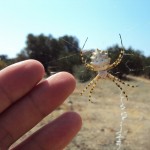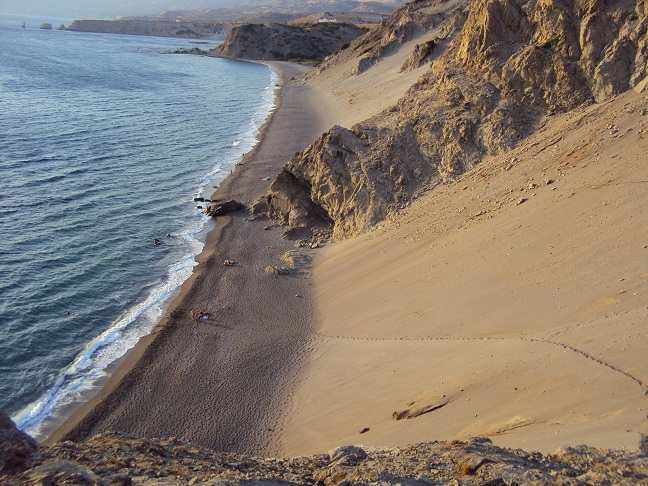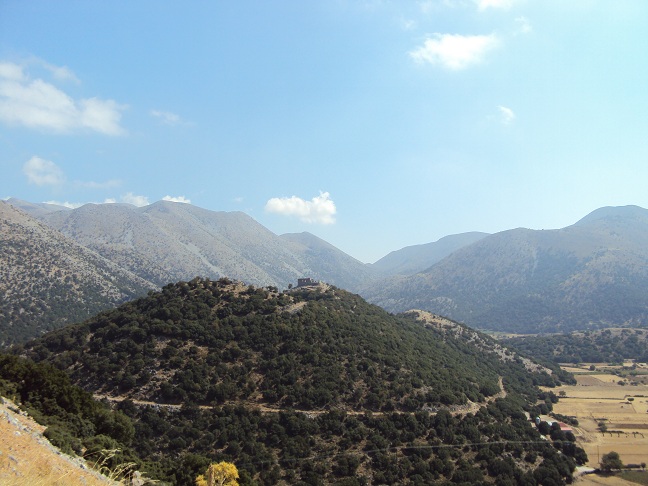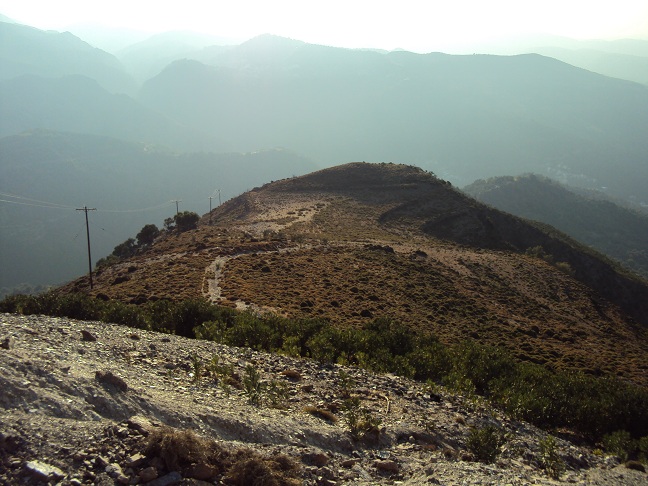
A lovely Argiope Lobata we came across. It’s venomous, but not dangerous. Filip’s fingers (I think) show the scale.
We left Aghia Pavlos with only a vague plan to explore West Crete. We settled on using a mixture of main and back roads. The Cretan landscape is extraordinarily complex and varied. Within minutes you can switch from something that looks like Afghanistan to something that looks like Bohemian or Southern Ontario woodland. Nothing can be reached in a straight line. A road between two villages, marked as a few kilometers long, will be precipitous climb by multiple switchbaks, or descend into a maze-like complex of canyons, and yet appear on the map in the “plains” region. Historians wonder if the complexity of Knossos’ floor plan inspired the myth of Theseus and the Labyrinth. Well, anything Cretan might have inspired it, because the whole land is a natural labyrinth, and any given patch of it is a labyrinth within a labyrinth, and every village is a labyrinth within a labyrinth within a labyrinth.
We began by going westward by an inland road, through Spili, turning south at the beginning of Notsifou Gorge. This we followed to the sea coast at Plakias. Proceeding westward along the narrow coastal plain, we passed by several other immense gorges. At Akrotiri Frangokastello, there was a Venetian fortress, beside which we picniced. A little further west, we turned inland again, following Imbros Gorge through a gap in the Lefka Ori ranges and descending the Kare Gorge to the northern main road at Vrises. From there, it was easy driving to Hania, Crete’s second city and port.
Poking around nearby Souda, we found the meticulously maintained Commonwealth War Cemetery. Crete played a strategic role in the Mediterranean theatre of World War II. Commonwealth forces tried to defend it against a massive Germn assault, but where forced out with heavy casualties. After the war, bodies were carefully hunted out, and re-buried in this spot, overlooking Souda Bay. About a third of the graves are unidentified. Of the remainder, the largest number are New Zealanders. I found a few Canadians, all RCAF airmen.
Hania preserves most of the Venetian heritage of the island. The old harbour has extensive Venetian-built fortifications and a lot of Italianate architecture. There’s also crumbling mosque from the Ottoman period, and minaret from a large one no longer extant. The central market place provided us with a stockpile of food. The taste in Crete is for sweet things —- there’s superb ice cream everywhere. But bread is another matter. Sometime in the Neolithic, I surmise, a boat-load of hard, stale bread must have reached Crete from Lebanon, and ever since then, that’s how Cretans have assumed bread should be. There’s a bakery in every village producing a hundred varieties of hard, crunchy bread, but soft bread is impossible to find. However, the same bakers produce wonderful flaky spinach, sweet cream, vegetable, and cheese pies, as well as excellent pastries. At a remote mountain stop, we had a marvellous orange pie.
Leaving Hania, our plan was to drive through the backroads until sunset approached, and find someplace to sleep. In this climate, a flat space and a sleeping bag is all you need to kip down. But finding a flat space is no small achievement. This must be the bumpiest, gorgiest, craggiest, most irregular place on the planet. Another challenge is finding any place that isn’t overun with sheep and goats. But every village seems to have a little chapel, neatly maintained, surrounded by graves, and walled off to keep out the livestock. There are also many such chapels along uninhabited roads, on remote crags, and on mountain peaks. Each has its icons and votive candles. The chapels have no human presence most of the time. We found an unobtrussive outside the village of Gregorio, and slept through the night within its precinct, surrouned by the dead.
But this was only after winding through a landscape yet more complex than all we had seen before. My little camera’s battery was exhausted by this point, and there are, at most, two or three more snaps possible.
The moon is full and bright. The dead here are not buried, but encased in above-ground sarcophagi, with photos attached. The faces of the elders stare at us as we sleep.



0 Comments.